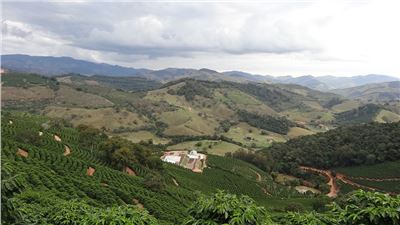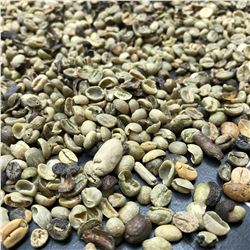
Snapshot from Origin: Brazil
Last month, Scott and Georgia visited the worlds largest producing origin; Brazil. They visited exporters and farmers to see how the 2017 harvest was progressing.
We flew into Sao Paulo on a cloudy June night, so the view of the city was obstructed, but the incandescent glow of the streetlights below lit the clouds like a sea of neon-orange fairy floss that stretched all the way to the horizon. Half the population of Australia lives in this city alone, and 200 million more reside in the country of Brazil. For me, the thought is mind boggling.
We took the new 6 lane high way south to the port city of Santos, where most of the coffee export brokers are located. Some 80% of all Brazilian export coffee is moved through here, an industry that runs like a well-oiled machine.
Chatting with the local operators here, we learned that the recent rains in the interior this season has meant the overall harvest has been delayed. This has caused the initial pickings to show a higher percentage of smaller beans - the flavors however are usual for this time of the year.
The coffee industry in Brazil is special to me not only because it’s the biggest volume producer in the world, but because through the production process, nothing is wasted. The system works roughly like this:
- The farmers harvest and process their own crop; generally naturals or pulp naturals dried on either a patio or raised African beds (a mechanical dryer might be used if they have one) and more rarely, fully washed lots. Most farmers have a decascadora (to remove the dry husk) or huller (to remove the parchment). They then bag the raw green, ready for sale to either a co-op or exporter. The farmer can sell their coffee directly to an exporter or cooperative themselves, or use a broker to find them the best offer.
- The exporter or co-op firstly inspects a sample of the farmers’ produce and hand-sorts the defects from the sample. They nominate the percentage that is usable for export and the remainder that is to be 'cleaned out' and sold into the internal market.
- The export-grade coffee sample is then roasted and cupped and a standard/grade is given to the lot based on both defect count and the number of clean cups. The flavor profile is largely ignored at this stage for commercial coffees. Depending on the services of the exporter or coop, further cupping may be carried out and a more accurate determination of quality can be made. High scoring coffees that are identified can be segregated and designated for sale as microlots or premium grades.
- The farmer is then paid for their lot of coffee, according to the proportion that is export grade and the proportion that will be sold to the internal market. If the lot is determined to be specialty-grade (generally cupping over 80 points SCA) an even higher premium can be awarded.
- The full lot of coffee, whether 1 bag or 1000 bags, is then delivered to the exporter or co-op storage facility where it will be dry milled, cleaned and separated into its grades.
In more recent times, Co-ops have opted to skip the step of further moving their finished goods through an exporter and have begun exporting their own coffees through to the international market. This method of vertical integration can improve cooperatives returns to farmers if its managed properly.

Internal Market Grade Green Coffee
The internal market is huge, one of the biggest in the world now - outranking the USA as the tenth-largest consuming nation. Locally, Brazilians are used to drinking all the secondary grade coffees - full of defects - that are not considered fit for export. The locals say the enjoy the 'strong' flavour, and while it may seem unjust to some that the producing country only drinks the second-rate stuff, someone has to drink it or it will go to waste- a costly and unsustainable outcome. Exporting the best beans strengthens the Brazilian coffee market for the future.
It turns out that in recent years the demand for coffee by the internal market has grown so much that more and more export-grade beans are being used to fulfill the local demand. While this is a good thing for Brazilian farmers - if the trend increases, we would see a shortage of well-priced commercial coffee overseas as Brazilians start to develop a taste for the good stuff.
The next generation producers surveying the field
On an encouraging note - we did meet a new generation of coffee farmers taking over from their parents and having a positive impact on their family farms. This could see a new wave of high quality, big volume growers in Brazil with higher levels of education and a more worldly, modern outlook to back them up. Farmers are becoming increasingly aware of the higher price premium that better cupping coffees can command, and with the incentives becoming more obvious as a path to greater returns, it’s likely we will see some high-quality cups being produced in the years to come.
Only time will tell....
Products list
Front mesh baseball cap with signature logo12341234
Jerome first appeared on the scene on 11 April 1970, and continues to make his mark.
Front mesh baseball cap with signature logo12341234
Jerome first appeared on the scene on 11 April 1970, and continues to make his mark.
Herschel backpack in dark blue12341234
The Front Trefoil first appeared on the scene in 1972, and it continues to make its mark.
Herschel backpack in dark blue12341234
The Front Trefoil first appeared on the scene in 1972, and it continues to make its mark.
Accessories Herschel backpack in dark blue12341234The Front Trefoil first appeared on the scene in 1972, and it continues to make its mark. | >
$56.99 |
Image
|
Description
| Property Name |
Stock
|
Price
|
|---|
Accessories Herschel backpack in dark blue1234Jerome first appeared on the scene in April 1970, and continues to make his mark. | 0 | 3 | 0 | 1 | $56.99 |
Image
|
Description
|
Stock
|
Week 1
|
Week 2
|
Week 3
|
Week 4
|
Price
|
|---|
Herschel backpack in dark blue12341234
The Front Trefoil first appeared on the scene in 1972, and it continues to make its mark.
Prod Name12341234
Jerome first appeared on the scene in 1970, and continues to make his mark.
Available balance
Reward balance
Pending balance
Neotek default product cap in black
1234
1234Neotek was the brain child of Jerome Howard and formed in late 2001 to create intuitive, efficient, integrated B2B eCommerce websites
Total price:
$159.99We offer free shipping anywhere in New Zealand. A skilled delivery team will bring the parcels into your office.
If you're not satisfied, return it for a full refund. We'll take care of disassembly and return shipping.

Herschel backpack in dark blue12341234
Jerome first appeared on the scene in 1970, and it continues to make his mark.
Lists are a convenient way to keep track of products you'd like to buy, buy regularly or want to keep a list for a specific event or time. Lists can help you with finding items so you don't have to search the entire site everytime you want to buy them. Lists can also help you remember to place an order for an event (function, birthday, wedding, Christmas etc)
How do I make a list?
To make a list, first go find all the products you want on your list, add them to your basket, and then click the save as list button in the basket, and this will turn all your items in your basket into a list
How do I add more items to a list?
Once you have found an item you want to add to an existing list, go to the details page of that item, and click the add to list button. This will then prompt you for which list to add it to. You can also start a new list this way, with this item as the first item on the new list.
How do I remove items from a list
On this page, find the list you want, and click on it to expand the items on the list, then you can remove items from the list by clicking the remove button next to each line.
How do I change the quantity of an item in the list
On this page, find the list you want, and click the plus or minus buttons to increase or descrease the quantity.
How do I remove a list
On this page, find the list you want, and click the delete button in the list summary.
What is a private list?
Lists can be private or public. A private list can only be used by you, meaning only you can see, use, modify and delete a private list. A public list can be used by all users on the account, which means any user on the account can see, use, modify and delete a public list.
Your order is complete!
Thank you for your order! Your order will be processed within 3-6 hours. You will receive an email confirmation when your order is processed.
All
The World
of Coffee
Generations of knowledge and global trading experience make us experts in connecting roasters to the world of coffee. Every day we share our knowledge and coffee expertise, supporting our partners to sustainably grow and prosper. The World of coffee features everything you need to know about coffee, where it comes from and what it takes to make the perfect cup.
Useful links
Generations of knowledge and global trading experience make us experts in connecting roasters to the world of coffee. Every day we share our knowledge and coffee expertise, supporting our partners to sustainably grow and prosper. The World of coffee features everything you need to know about coffee, where it comes from and what it takes to make the perfect cup.






